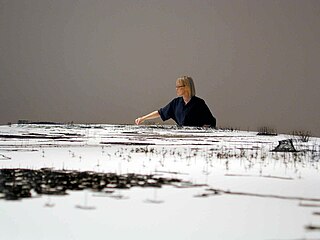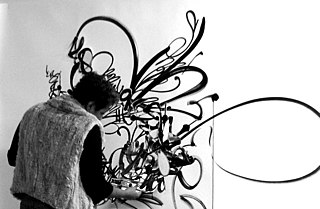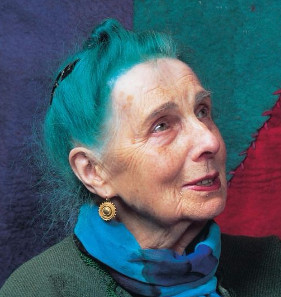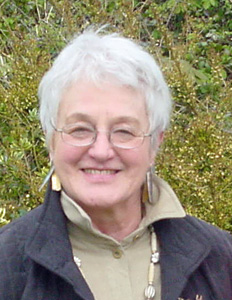
Embroidery is the art of decorating fabric or other materials using a needle to stitch thread or yarn. Embroidery may also incorporate other materials such as pearls, beads, quills, and sequins. In modern days, embroidery is usually seen on caps, hats, coats, overlays, blankets, dress shirts, denim, dresses, stockings, scarfs, shoes, handbags and golf shirts. Embroidery is available in a wide variety of thread or yarn colour. It is often used to personalize gifts or clothing items.

A quilt is a multi-layered textile, traditionally composed of two or more layers of fabric or fiber. Commonly three layers are used with a filler material. These layers traditionally include a woven cloth top, a layer of batting or wadding, and a woven back combined using the techniques of quilting. This is the process of sewing on the face of the fabric, and not just the edges, to combine the three layers together to reinforce the material. Stitching patterns can be a decorative element. A single piece of fabric can be used for the top of a quilt, but in many cases the top is created from smaller fabric pieces joined, or patchwork. The pattern and color of these pieces creates the design.
Marie Watt is a contemporary artist living and working in Portland, Oregon. Enrolled in the Seneca Nation of Indians, Watt has created work primarily with textile arts and community collaboration centered on diverse Native American themes.

Fiber art refers to fine art whose material consists of natural or synthetic fiber and other components, such as fabric or yarn. It focuses on the materials and on the manual labor on the part of the artist as part of the works' significance, and prioritizes aesthetic value over utility.

Phulkari refers to the folk embroidery of the Punjab and Gulkari of Sindh in South Asia. Although Phulkari means floral work, the designs include not only flowers but also cover motifs and geometrical shapes. The main characteristics of Phulkari embroidery are use of darn stitch on the wrong side of coarse cotton cloth with coloured silken thread. Punjabi women create innumerable alluring and interesting designs and patterns by their skilful manipulation of the darn stitch. According to Kehal (2009), a cloth where only a few flowers are embroidered is called a Phulkari. The other types are distinct varieties. The traditional varieties of Phulkaris are large items of cloth and include Chope, Tilpatr, Neelak and Bagh. Sometimes, the Bagh is given separate categorization of its own as on other varieties of a Phulkari, parts of the cloth is visible, whereas in a Bagh, the embroidery covers the entire garment so that the base cloth is not visible. Further, in contemporary modern designs, simple and sparsely embroidered dupattas, odhinis, and shawls, made for everyday use, are referred to as phulkaris, whereas clothing items that cover the entire body, made for special and ceremonial occasions such as weddings are called baghs. The Phulkari continues to be an integral part of Punjabi weddings to the present day.

Anne Wilson is a Chicago-based visual artist. Wilson creates sculpture, drawings, Internet projects, photography, performance, and DVD stop motion animations employing table linens, bed sheets, human hair, lace, thread and wire. Her work extends the traditional processes of fiber art to other media. Wilson is a professor in the Department of Fiber and Material Studies at The School of the Art Institute of Chicago.
Nava Lubelski is a contemporary artist who works and lives in Asheville, North Carolina.
China Marks is an American artist creating process-directed sewn drawings and books.

Shinique Smith is an American visual artist, known for her colorful installation art and paintings that incorporate found textiles and collage materials. She is based in Los Angeles, California.
Rebecca Ringquist is a Portland, Oregon-based visual artist. Ringquist creates embroidered artwork and runs her own design company, Dropcloth Samplers. Her work extends the traditional processes of Fiber art by dealing with vintage fabrics, utilizing the sewing machine, and applying hand-embroidery techniques. Ringquist was a professor for seven years in the Department of Fiber and Material Studies at The School of the Art Institute of Chicago. She is also the author of Rebecca Ringquist's Embroidery Workshops: A Bend the Rules Primer.

Billie Zangewa is a Malawian artist who hand sews silk fabrics to create collage tapestries, and who now lives in Johannesburg. Since 2004, her art has featured in international exhibitions including at the Paris Art Fair at the Grand Palais in Paris.
The 62 Group of Textile Artists is an international group of professional textile artists founded in the United Kingdom in 1962. The group is a Constituted Artists Co-operative, focussed on exhibiting the work of its members in the UK and overseas. Membership of the group is achieved through a selection process. The 62 Group requires members to submit work to a selection panel of their peers for every exhibition "If members fail to submit, or are rejected for three successive exhibitions, then membership is forfeited...a policy which ensures that the group consistently produces exciting work." The increased profile of textile art and its evolution in the latter part of the 20th century "has to a great extent been dictated by members of the 62 Group."

Constance Mildred Howard, later Constance Parker, was an English textile artist and embroiderer who had a profound impact on the development and teaching of those subjects in Britain. The Constance Howard Gallery, part of Goldsmiths, University of London, is named in her honour.
Louisa Pesel (1870–1947) was an English embroiderer, educator and textile collector. She was born in Bradford, and studied textile design at the National Art Training School, causing her to become interested in decorative stitchery. She served as the director of the Royal Hellenic School of Needlework and Lace in Athens, Greece, from 1903 to 1907. Pesel served as the first president of the Embroiderers' Guild. She produced samplers for the Victoria and Albert (V&A) Museum and cushions, kneelers, alms bags and a lectern carpet for Winchester Cathedral. She collected textiles extensively, and following her death in Winchester in 1947, her collection went to the University of Leeds.

Mary Cozens-Walker was an English textile artist and painter best known for her three-dimensional works pertaining to her own domestic life. She exhibited in the United Kingdom, Japan, and the United States. She has appeared as a model in about 600 paintings. Her own work is in national collections and paintings of her are also in national collections.
Karen Hampton is an American textile artist, working as a weaver, surface designer, and fabric dyer. She has also worked as a researcher on the history of textile production. As of 2022, she was named a Fellow of the American Craft Council. Hampton lives in Los Angeles.

Audrey Walker was an accomplished textile artist, embroiderer and teacher, who was active from the 1970s and 1990s in United Kingdom. Walker became known for developing an innovative style of embroidery based on fine threads applied by machine and by hand, to create striking figurative wall-hung works of art. Walker described her work as evolving from fairly fluid ideas, and the process as being akin to drawing with fabrics.
Alicja (Alice) Kozłowska is a contemporary Polish mixed media and textile artist.

Linda Gass is an American environmental activist and artist known for brightly colored quilted silk landscapes, environmental works, and public art sculptures, which reflect her passion for environmental preservation, water conservation and land use.
Kyung-Ah Ham is a contemporary multi-media artist working in Seoul. Her works utilize handmade North Korean textiles to discuss the social and political complexities between South and North Korea.
![Marshland - Twilight (2010) by Barbara Lee Smith; 49.5" x 39" [private collection] photo by Tom Holt Marshland - Twilight.jpg](http://upload.wikimedia.org/wikipedia/commons/thumb/3/34/Marshland_-_Twilight.jpg/220px-Marshland_-_Twilight.jpg)












